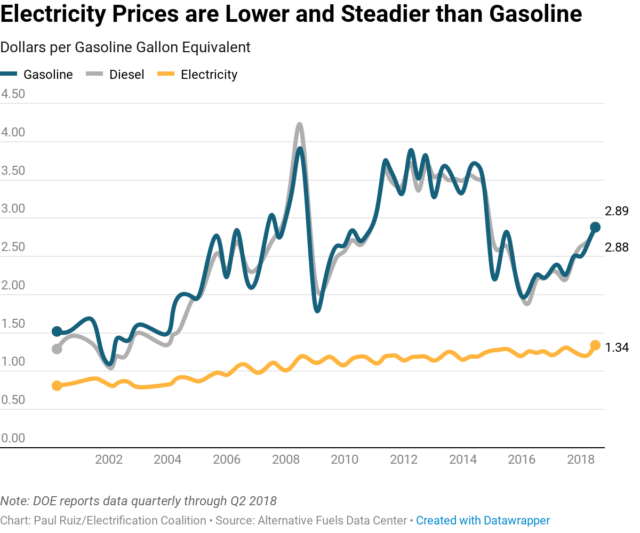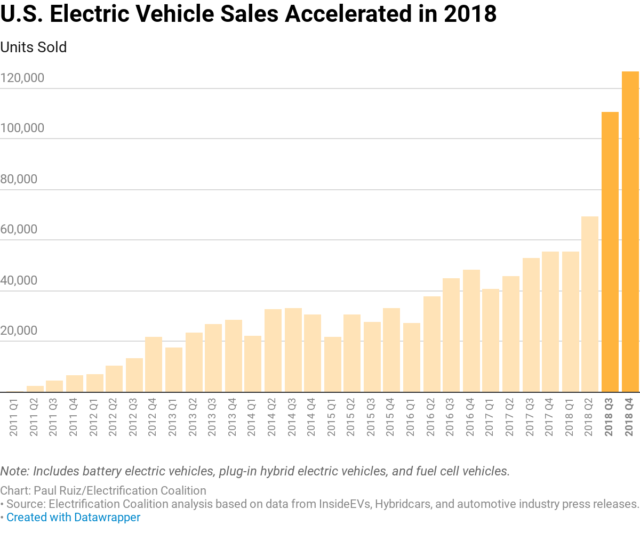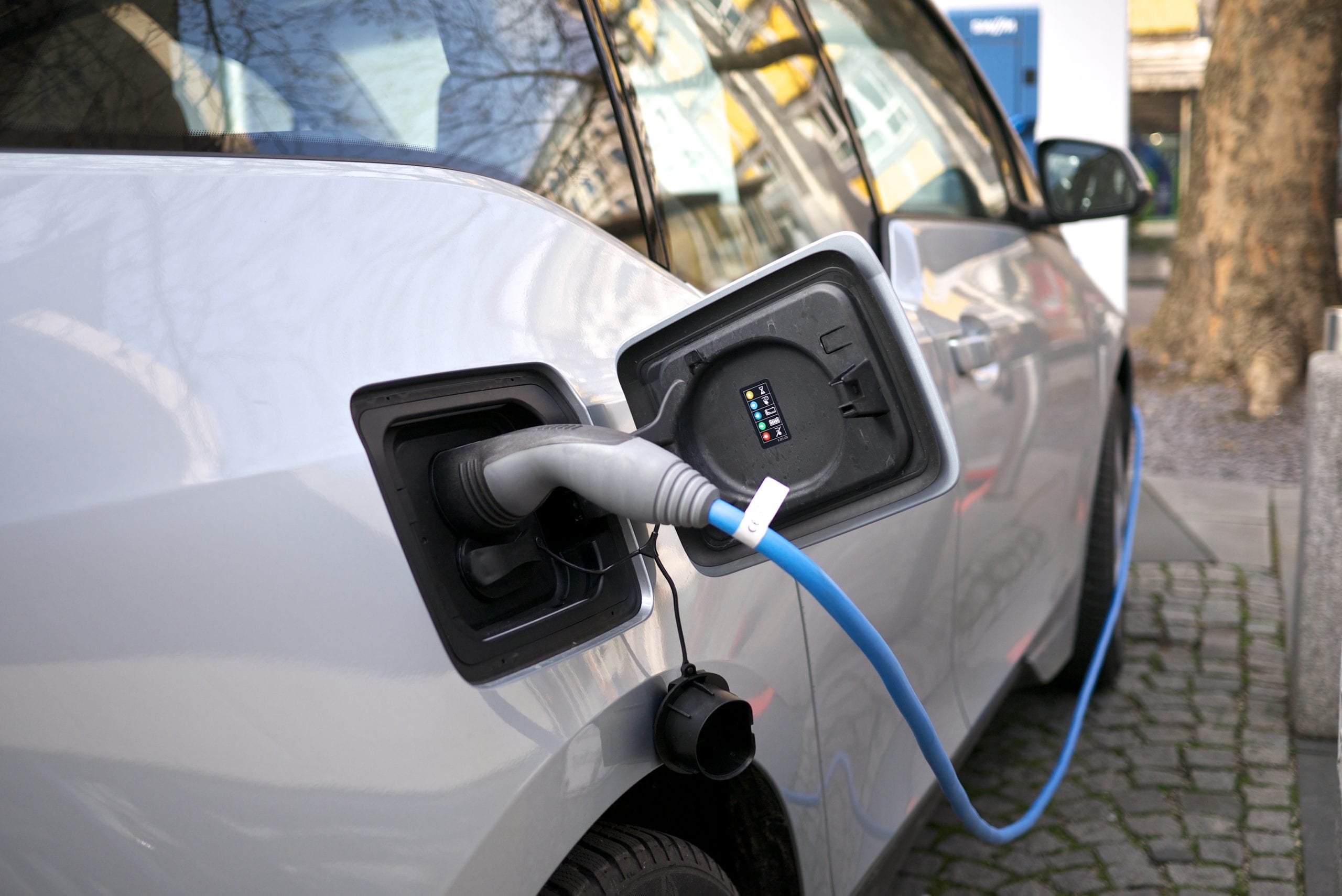On Friday, February 1, ACT News published Volume 1 of a two-part series on the growing trend of light-duty fleet electrification. This piece is intended to showcase a specific aggregated procurement program called the Climate Mayors Electric Vehicle (EV) Purchasing Collaborative (the Collaborative), which was launched in fall 2018.
An Overview of the Collaborative
The Collaborative is a catalyst for accelerating the transition of city fleets to EVs, cutting emissions, reducing the United States’ dependence on oil, and saving taxpayer money. The accelerated transition of municipal fleets to EV is achieved through this initiative by providing cities with the right tools to make EV purchases and acquire charging infrastructure to support electrified fleets.
In 2017, Los Angeles Mayor Eric Garcetti led the release of an EV RFI with 30 cities to demonstrate demand for more than 114,000 EVs, trucks, and equipment. Since then, the Climate Mayors effort has evolved into a commitment by more than 400 U.S. mayors, representing 70 million Americans from 47 states who have pledged to adopt, honor, and uphold the goals of the Paris Climate Agreement. To address these challenges, the Climate Mayors, the Electrification Coalition (EC) and Sourcewell launched the Collaborative (www.DriveEVfleets.org) in September 2018 to create a one-stop platform for fleets to make cost-effective purchasing decisions, bring nationwide cost parity to the available EV models, and to help cities and other public agencies capture the federal tax credits through an innovative municipal capital-leasing purchase model. Providing fleet electrification expertise as the Collaborative’s technical adviser, the EC is also centralizing important data and best practices on how to buy, lease, or contract the services of EVs, as well as display a host of vendors for the acquisition of charging infrastructure.
The accelerated transition of municipal fleets to EV is achieved through this initiative by providing cities with the right tools to make EV purchases and acquire charging infrastructure to support electrified fleets.
Go to www.DriveEVfleets.org if your city is interested in learning more and joining the founding cities that have already committed to transition their fleets.
The Benefits of EVs
EVs offer an economically-viable, in many cases economically superior, alternative to internal combustion engines (ICEs). In the long run, battery electric vehicles (BEVs) and plug-in hybrid electric vehicles (PHEVs) are cheaper to own and operate because they deliver price stability, lower fuel costs, and require less maintenance and service than ICEs. Fleet operators can entirely avoid ICEs’ repeated periods of downtime due to costly oil and transmission fluid changes, and other engine-related services. In contrast, because EVs have fewer parts, they require significantly less maintenance. While overseas events cause oil prices to fluctuate, electricity is generated domestically, resulting in fuel costs that are both lower and steadier for EVs versus ICEs.

The Increasing Sales of Electric Vehicles
Last year, automakers sold more than 362,000 EVs, an 81 percent increase over 2017 and the best year on record in terms of total sales volumes. This year and next, a dozen new BEVs and PHEVs will be introduced with a growing share of the new additions fulfilling popular consumer and public fleet interests like sports-utility vehicles and the announcement of plug-in light-duty trucks. There are now more than 16 BEV models and 29 PHEV models available, an increase from 15 BEV and 24 PHEV models available in 2017. As battery costs continue to decline, analysts project a growing number of EVs will run further on a single charge and at lower costs. The Collaborative provides further benefit to fleets by making more EV models available in areas of the U.S. which have not seen diverse model selection yet.

Despite these rising sales figures, EVs nevertheless represent just one out of every 50 new vehicles sold in the United States, a share that is undoubtedly better than the nascent market of only a few years ago but still a niche within a car market that sold more than 17.4 million units last year. According to the latest data from the Bureau of Economic Analysis and InsideEVs, the combined category for BEVs and PHEVs accounted for just above two percent of new vehicle sales in the United States.
Many of those sales have been concentrated in states with robust zero emission vehicle (ZEV) mandates and programs, which require OEMs to sell a certain amount of plug-in electric vehicles. ZEV states often augment private sector investment with public sector commitments to build EV charging infrastructure, support consumer incentives, and engage consumers in outreach and education campaigns. Consequently, EV sales in ZEV states have been generally higher than national averages.
The Transition to EVs for Municipal Governments
If dedicated state policy can accelerate EV adoption, so too can municipal governments. Cities can transition their fleets to electric, enact EV-ready building codes, create dedicated carpool lanes, facilitate workplace charging programs, streamline EV charging station permitting processes, and install city-owned chargers—all meaningful initiatives that increase the visibility of EVs and promote public awareness.
Many of the 400 cities that are part of the Climate Mayors initiative have enacted comprehensive EV-integration plans that save money and reduce air pollution.
Many of the 400 cities that are part of the Climate Mayors initiative have enacted comprehensive EV-integration plans that save money and reduce air pollution. The City of Los Angeles, an early leader in municipal fleet EV deployment, is transitioning 137 of their planned city vehicles to PHEVs through the Collaborative, the City of Austin is integrating 71 EVs into its municipal fleet through this program, and smaller cities such as Chula Vista, CA and Rochester, NY are finding EV opportunities as well. These combined fleet electrification strategies promise to transform the overall EV market, as motorists visibly see electrified fleet vehicles on city roads.
The large-scale fleet electrification commitments from the Climate Mayors EV Purchasing Collaborative cities continue to encourage other municipal leaders to join the effort. Creating a pathway for cities of all sizes to smoothly and cost-effectively electrify fleets will help the United States create a viable pathway to increase the market penetration of EVs and maintain its stated climate goals from the Paris Climate Agreement. To learn more and join the collaborative you can visit the website www.DriveEVfleets.org or come to the upcoming ACT Expo and go the upcoming panel hosted by the Electrification Coalition and the other members of the collaborative.



